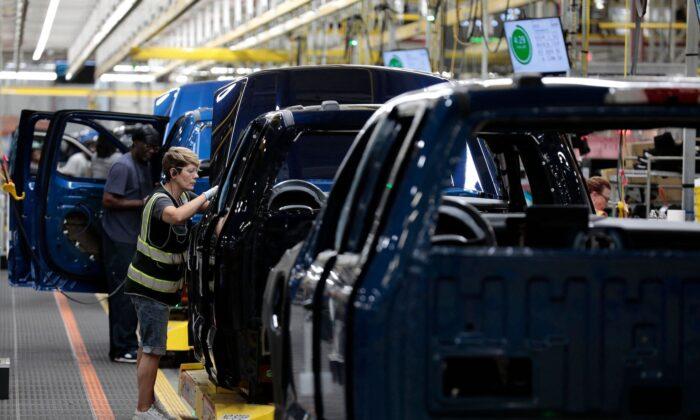Commentary
Ford Motor Co.
recently announced that it’s slashing prices on its F-150 Lightning, an electric vehicle (EV) the company rolled out in 2021.
The Lightning now carries a suggested retail price of $49,995, about $10,000 lower than its previous recommended price tag ($59,974), a reduction that the company says is possible because of lower “battery raw material costs and continued work on scaling production and cost.”
It’s certainly possible that reduced overhead from battery minerals and production costs played a role in Ford’s decision to trim its price tag by nearly 20 percent, but that may be only half the story.
Several reports show that EVs aren’t exactly flying off dealership lots. In fact, there’s a glut of them.
“After a prolonged period in which EVs quickly disappeared from dealerships, the electric vehicle industry now has the opposite problem: unsold models are piling up,” Money
reported on July 11. “About 92,000 EVs currently sit on dealers’ lots; that’s a 342% increase from a year ago, when only about 21,000 did so, according to automotive research firm Cox Automotive.”
Ford isn’t immune from the weakened demand for EVs. Sales of its flagship EV, the Mustang Mach-E,
slumped by 44 percent in May compared with the same month last year.
The Lightning, which won the title of EV king of pickup trucks after Ford moved nearly 16,000 units in 2022, has fared better but is still
struggling to keep pace with its 2022 numbers. And now the company is facing some stiff new competition. (More on that in a minute.)
This wasn’t the scenario many people predicted.
In April, the International Energy Agency
released a report in which it predicted EV sales to increase by 35 percent after a record-breaking year. But economists I spoke with said such predictions were overly optimistic considering current macroeconomic conditions.
This invites important questions. Is the glut of EVs simply a product of tightened money supply?
Apparently not. As Axios
noted, the 92,000 EVs currently sitting on lots is high relative to gasoline-powered cars.
“That’s a 92-day supply—roughly three months’ worth of EVs, and nearly twice the industry average,” Joann Muller wrote. “For comparison, dealers have a relatively low 54 days’ worth of gasoline-powered vehicles in inventory.”
In other words, dealerships are sitting on a lot more EVs than gasoline-powered vehicles—despite efforts to entice consumers to buy EVs with taxpayer-funded credits
up to $7,500.
This is evidence that pretty much everyone—from central planners to auto manufacturers—misjudged the demand for EVs, which aren’t even as environmentally friendly as politicians would have you believe.
Not only do EVs require an astonishing amount of mining—
an estimated 500,000 pounds of rock and minerals must be upturned to make a single battery, physicist Mark Mills told Reason—but their carbon footprint isn’t much smaller than that of gas-powered cars.
It turns out that EVs actually require a lot more CO2 to produce than gas-powered cars. EVs can make that up, but it takes a great deal of time because EVs also often run on electricity generated from fossil fuels. Just how long does it take? In 2021, Volvo
stated that its C40 Recharge has to be driven 70,000 miles before its carbon impact is lower than that of its gas-powered version.
All of this is to say that a bunch of unused EVs isn’t just a financial headache for auto dealers and motor companies; it’s also an environmental problem.
That said, the weaker-than-expected demand for EVs doesn’t mean that the future of EVs is doomed. On the contrary, demand for EVs is likely to increase as battery technology and EV infrastructure improve. Ford’s Lightning, for example, has only half the range of its gas-powered F-150 because of its small battery—a clear concern when charging stations aren’t yet readily available in many places.
For now, however, motor companies are competing with one another to attract customers in a smaller-than-anticipated EV market. Which brings me to Elon Musk.
Earlier in July, Tesla
rolled out its much-hyped Cybertruck, which is a direct challenge to the Lightning and likely played a role in Ford’s price cut.
Federal lawmakers may have created a glut of EVs with their meddling, and it’s likely to have an adverse effect on both the auto market and the environment. But one of the virtues of capitalism is that
consumers will ultimately decide who wins in the EV market and who loses.
Whether that turns out to be Mr. Musk’s Cybertruck or Ford’s Lightning remains to be seen. Either way, the competition is bringing down prices, which is a win for consumers looking to purchase an EV.
But the glut of EVs on the market reveals the danger of letting lawmakers decide what consumers should be driving.
Views expressed in this article are opinions of the author and do not necessarily reflect the views of The Epoch Times.





